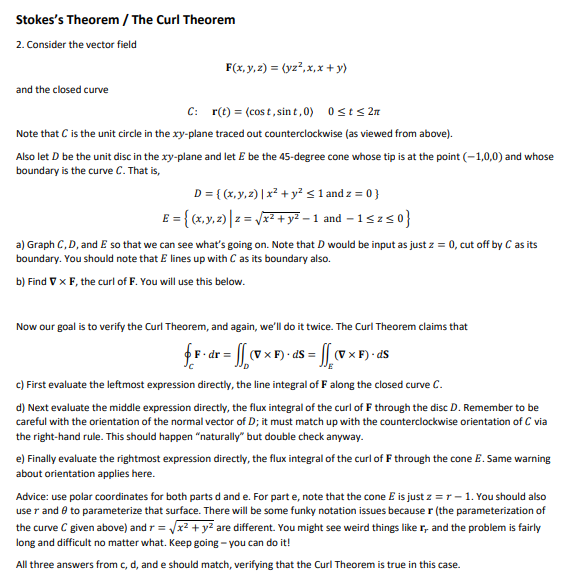Stokes's Theorem / The Curl Theorem 2. Consider the vector field F(x,y,2) = (yz²,x,x +y) and the closed curve C: r(t) = (cos t,sin t,0) 0sts 2n Note that C is the unit circle in the xy-plane traced out counterclockwise (as viewed from above). Also let D be the unit disc in the xy-plane and let E be the 45-degree cone whose tip is at the point (–1,0,0) and whose boundary is the curve C. That is, D = { (x,y.2) |x² + y²< 1and z = 0} E = { (x,y.2)|2= J +y?-1 and – 13z<0} a) Graph C, D, and E so that we can see what's going on. Note that D would be input as just z = 0, cut off by C as its boundary. You should note that E lines up with C as its boundary also. b) Find Vx F, the curl of F. You will use this below. Now our goal is to verify the Curl Theorem, and again, we'll do it twice. The Curl Theorem claims that -dr = (V × F) « (V x F) - ds c) First evaluate the leftmost expression directly, the line integral of F along the closed curve C.
Stokes's Theorem / The Curl Theorem 2. Consider the vector field F(x,y,2) = (yz²,x,x +y) and the closed curve C: r(t) = (cos t,sin t,0) 0sts 2n Note that C is the unit circle in the xy-plane traced out counterclockwise (as viewed from above). Also let D be the unit disc in the xy-plane and let E be the 45-degree cone whose tip is at the point (–1,0,0) and whose boundary is the curve C. That is, D = { (x,y.2) |x² + y²< 1and z = 0} E = { (x,y.2)|2= J +y?-1 and – 13z<0} a) Graph C, D, and E so that we can see what's going on. Note that D would be input as just z = 0, cut off by C as its boundary. You should note that E lines up with C as its boundary also. b) Find Vx F, the curl of F. You will use this below. Now our goal is to verify the Curl Theorem, and again, we'll do it twice. The Curl Theorem claims that -dr = (V × F) « (V x F) - ds c) First evaluate the leftmost expression directly, the line integral of F along the closed curve C.
Algebra and Trigonometry (MindTap Course List)
4th Edition
ISBN:9781305071742
Author:James Stewart, Lothar Redlin, Saleem Watson
Publisher:James Stewart, Lothar Redlin, Saleem Watson
Chapter9: Vectors In Two And Three Dimensions
Section9.FOM: Focus On Modeling: Vectors Fields
Problem 11P
Related questions
Question

Transcribed Image Text:Stokes's Theorem / The Curl Theorem
2. Consider the vector field
F(x, y, 2) = (yz?,x,x + y)
and the closed curve
C: r(t) = (cos t, sin t,0) 0sts 27
Note that C is the unit circle in the xy-plane traced out counterclockwise (as viewed from above).
Also let D be the unit disc in the xy-plane and let E be the 45-degree cone whose tip is at the point (-1,0,0) and whose
boundary is the curve C. That is,
D= { (x,y,2) | x² + y²<1 and z = 0 }
E = { (x,y.2)| z = J + y? – 1 and – 1szs0}
a) Graph C,D, and E so that we can see what's going on. Note that D would be input as just z = 0, cut off by C as its
boundary. You should note that E lines up with C as its boundary also.
b) Find V x F, the curl of F. You will use this below.
Now our goal is to verify the Curl Theorem, and again, we'll do it twice. The Curl Theorem claims that
fF- dr = |v x F) - as = v×F) - as
c) First evaluate the leftmost expression directly, the line integral of F along the closed curve C.
d) Next evaluate the middle expression directly, the flux integral of the curl of F through the disc D. Remember to be
careful with the orientation of the normal vector of D; it must match up with the counterclockwise orientation of C via
the right-hand rule. This should happen "naturally" but double check anyway.
e) Finally evaluate the rightmost expression directly, the flux integral of the curl of F through the cone E. Same warning
about orientation applies here.
Advice: use polar coordinates for both parts d and e. For part e, note that the cone E is just z = r - 1. You should also
use r and e to parameterize that surface. There will be some funky notation issues because r (the parameterization of
the curve C given above) and r = r2 + yz are different. You might see weird things like r, and the problem is fairly
long and difficult no matter what. Keep going – you can do it!
All three answers from c, d, and e should match, verifying that the Curl Theorem is true in this case.
Expert Solution
This question has been solved!
Explore an expertly crafted, step-by-step solution for a thorough understanding of key concepts.
Step by step
Solved in 6 steps with 4 images

Knowledge Booster
Learn more about
Need a deep-dive on the concept behind this application? Look no further. Learn more about this topic, advanced-math and related others by exploring similar questions and additional content below.Recommended textbooks for you

Algebra and Trigonometry (MindTap Course List)
Algebra
ISBN:
9781305071742
Author:
James Stewart, Lothar Redlin, Saleem Watson
Publisher:
Cengage Learning

Algebra and Trigonometry (MindTap Course List)
Algebra
ISBN:
9781305071742
Author:
James Stewart, Lothar Redlin, Saleem Watson
Publisher:
Cengage Learning